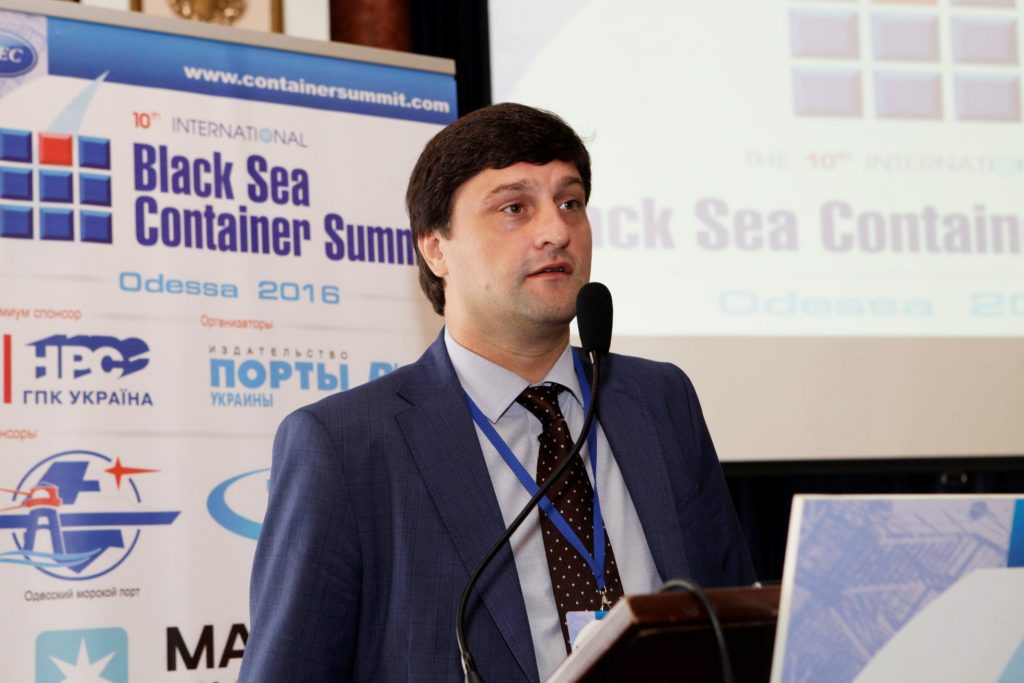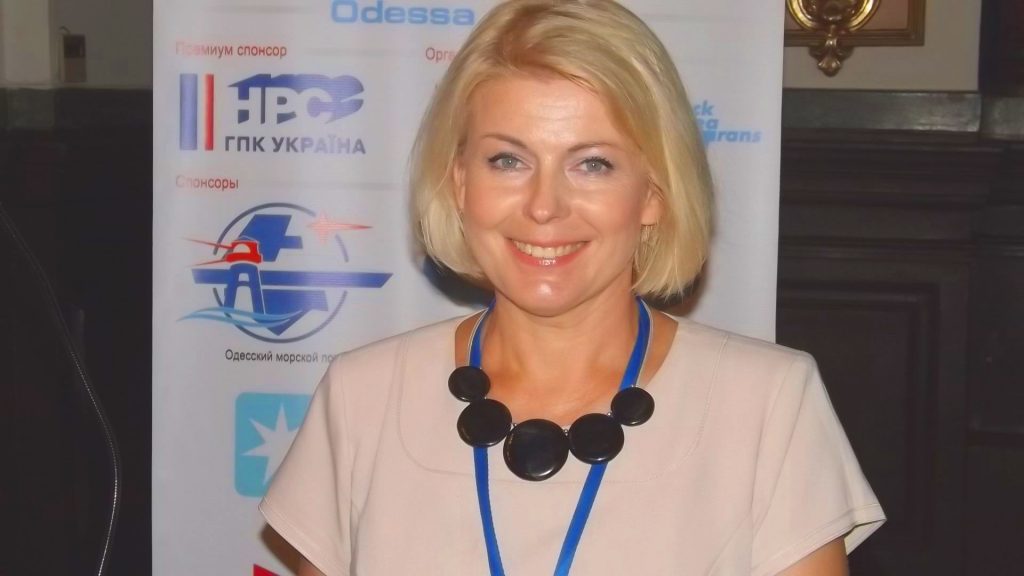 (from the issue №3, 147, October) Cargo traffic falling in recent years, low utilization of the transshipment facilities accompanying with their overage, high cost of vessel calls at the sea ports and the weak purchasing power of the population inside the country – are the main factors that determine today’s situation on the market of container handling in Ukraine. This was stated by the participants of the 10th International «Black Sea Container Summit – 2016».
(from the issue №3, 147, October) Cargo traffic falling in recent years, low utilization of the transshipment facilities accompanying with their overage, high cost of vessel calls at the sea ports and the weak purchasing power of the population inside the country – are the main factors that determine today’s situation on the market of container handling in Ukraine. This was stated by the participants of the 10th International «Black Sea Container Summit – 2016».
The forum brought together more than a hundred nautical practitioners and representatives of the companies operating in the container transport field. It is symbolic that it coincided with another anniversary: 60 years ago, a truck driver from North Carolina Malcolm McLean invented the 20-foot container.
Draft off the bottom
In 2001, the era of fierce competition in the field of container transport began. In the struggle to save every penny, or lari (or hryvnia) market «players» became governors of this tariff war. From here – the ups and downs, making a graph of the container sea transportation results similar toa roller coaster ride. Since 2001, the curve was rising. The Container Summit participants spoke well about the peak results in 2008, when Ukraine transshipped about 1.5 million TEU per year. We were giving ground due to the progression of the crisis, and then, the pressure of political circumstances.
 But still in 2016 there is an upward trend. For example, marine terminals in Ukraine during 8 months of this year handled 320 thousand TEU, i.e 18% more than in the same period of 2015. According to the Minister of Infrastructure of Ukraine Vladimir Omelyan, this indicates that policies aimed at deregulation, simplification of business conditions, yields results and that the business has felt its power. «We remove the state from all spheres that affect the business», – he said during the summit.
But still in 2016 there is an upward trend. For example, marine terminals in Ukraine during 8 months of this year handled 320 thousand TEU, i.e 18% more than in the same period of 2015. According to the Minister of Infrastructure of Ukraine Vladimir Omelyan, this indicates that policies aimed at deregulation, simplification of business conditions, yields results and that the business has felt its power. «We remove the state from all spheres that affect the business», – he said during the summit.
Troublesome time has not stopped the enthusiasts of the new terminals construction. Like Ukrainian businessmen foresaw that container traffic growth will outpace world GDP and world trade. According to its reloading capacities today Ukraine shows up among the other Black Sea countries. Our country is capable to transship up to 3 million TEU a year. At the same time, experts say, these powers are involved only at 16.5%.
Ministry reaction
Whether the Ministry of Infrastructure of Ukraine (MIU) is worried about this fact?
 — Yes, – The Deputy Director of the Department of state policy in the field of maritime and river transport of MIU Alexander Basyuk answers. – For our part, we have introduced the measures to facilitate the involvement of vessels and cargo, transported by containers. The attractiveness of vessel calls is ensured by the deregulation of the control system. The number of documents required for entering the port, is reduced from 18 to 4, the number of paid services, previously imposed during port calls, reduced from 37 to 4. Workflow takes place in electronic form. Forwarders have the opportunity to make up the automobile’s way to the port before the ship’s arrival. After the negotiations with the fiscal service customs procedures were simplified.
— Yes, – The Deputy Director of the Department of state policy in the field of maritime and river transport of MIU Alexander Basyuk answers. – For our part, we have introduced the measures to facilitate the involvement of vessels and cargo, transported by containers. The attractiveness of vessel calls is ensured by the deregulation of the control system. The number of documents required for entering the port, is reduced from 18 to 4, the number of paid services, previously imposed during port calls, reduced from 37 to 4. Workflow takes place in electronic form. Forwarders have the opportunity to make up the automobile’s way to the port before the ship’s arrival. After the negotiations with the fiscal service customs procedures were simplified.
And yet it is not so much a guarantee but a hope for success.
***
According to the organizing committee of the Container Summit, in 2015, container turnover in the ports of the Black Sea region (excluding transshipment) decreased by 12.7%. In the first half of 2016 the situation was stabilized: in general, in the region container turnover increased by 2.7% against the first half of 2015. The stabilization has occurred, primarily due to the growth of container handling the Ukrainian ports – by 25.7%. At the same time the turnover of goods in the Black Sea and Azov ports of Russia increased by 4.13%, and in Romania – by 3.47%. At the same time in the ports of Georgia the transshipment reduced by 26% — and by 2.14% in Bulgaria.
Ship calls logic is defined by their value
 During the «Black Sea Container Summit» the CEO of the SC «HPC Ukraina» (Odessa sea port) Anastas Kokkin suggested more radical means of attracting container flows into the ports. In his opinion, the conditions for the growth of container turnover would be created by the privatization of the state port operators (stevedoring companies). The reasoning is simple: private owner is not afraid to work in a mobile system of tariffs.
During the «Black Sea Container Summit» the CEO of the SC «HPC Ukraina» (Odessa sea port) Anastas Kokkin suggested more radical means of attracting container flows into the ports. In his opinion, the conditions for the growth of container turnover would be created by the privatization of the state port operators (stevedoring companies). The reasoning is simple: private owner is not afraid to work in a mobile system of tariffs.
The figures convince that money remains the key to the competitiveness of the port. Thus, the cost of call in the port of Constanta (Romania) is 71,109.65 dollars. In the young Turkish port Evyap – 75,397 dollars. In the port of Odessa – 157,215.68 USD. At that, the quality and speed of container handling is about the same.
On the agenda we have the question what is better: the state regulated prices – or free allocated for market judgment ones? The prices, competitive with those that exist in Romania, Turkey, Georgia (or dictated by the owners of the shipping container lines, with the price attacks of which the state port operators in Ukraine tried to fight)?
Meanwhile, from the data for comparison, presented by Anastas Kokkin, follows an eloquent conclusion: container loading in Turkey is $40, in Romania – up to $80, and in Ukraine is much higher – $190.
There are cases when the operators reduce prices for handling of the empty container to $35. They are on the brink of the risk of falling into negative, but still they are able to attract and retain the flow.
The State has to solve a difficult dilemma. Should we increase port fees? But this is a clearly unproductive way. Reduce tariffs, while experiencing hunger for loads? You can simply «go bust»!
Defending the position of privatization of state stevedores, as a way to reduce the cost of ship calls, the reporter noted that in Ukraine more than 60% of cargo is processed by private operators. Today few companies are comfortable with rent, as a kind of partnership. The concession is declared, but never implemented. This form, as a joint venture enterprise, is prohibited. Privatizationis — possible.
 With the fact that the majority of state programs in Ukraine is carried out by private companies, the deputy chairman of the Ukrainian Sea Ports Authority Vyacheslav Voronoy fully agrees. In particular, he considers the method of filling the public purse at the expense of withdrawal of 75% of the profits of enterprises an extortionate one. There is the promise of Prime Minister of Ukraine Vladimir Groisman on the abolition of such principle of funds allocation. But the end of the year is approaching, and in the ports they do not know how to make financial plans. Obviously, it is necessary to prepare two projects. And in any case – to think hard on attracting external funding.
With the fact that the majority of state programs in Ukraine is carried out by private companies, the deputy chairman of the Ukrainian Sea Ports Authority Vyacheslav Voronoy fully agrees. In particular, he considers the method of filling the public purse at the expense of withdrawal of 75% of the profits of enterprises an extortionate one. There is the promise of Prime Minister of Ukraine Vladimir Groisman on the abolition of such principle of funds allocation. But the end of the year is approaching, and in the ports they do not know how to make financial plans. Obviously, it is necessary to prepare two projects. And in any case – to think hard on attracting external funding.
Domestic demand for goods – the «key to the casket»
 Export dominates in the structure of container transport of Ukraine, says the head of the sector of transport infrastructure of the National Institute for Strategic Studies (NISS) Yekaterina Mikhaylichenko. Its volume in comparison with 2013 year fell by half, reaching 16.6 million tons during 8 months of 2016. Basically, according to the nomenclature, it is metal and grain, which exports actually increased. This applies to agricultural products such as sunflower oil, corn, and, traditionally, wheat. The last one, as a product is very interesting for American traders who rely on export from Ukraine of 36 million tons of grain. And not in bulk, but in 20-foot «boxes». A positive trend here is that more goods will be transported in containers. In the meantime, the degree of containerization in the country barely reaches 1%.
Export dominates in the structure of container transport of Ukraine, says the head of the sector of transport infrastructure of the National Institute for Strategic Studies (NISS) Yekaterina Mikhaylichenko. Its volume in comparison with 2013 year fell by half, reaching 16.6 million tons during 8 months of 2016. Basically, according to the nomenclature, it is metal and grain, which exports actually increased. This applies to agricultural products such as sunflower oil, corn, and, traditionally, wheat. The last one, as a product is very interesting for American traders who rely on export from Ukraine of 36 million tons of grain. And not in bulk, but in 20-foot «boxes». A positive trend here is that more goods will be transported in containers. In the meantime, the degree of containerization in the country barely reaches 1%.
The main buyers of Ukrainian foodstuffs are Latin American countries, Africa and Asia. The yield on a full European market is prestige, but difficult. The Free Trade Agreement with EU has not yet yielded results. At the same time the EU is Ukraine’s main trading partner for imports, although this volume is «squeezed» as well. According to NISS, the import in containers, compared with the year 2013 decreased as well as export.
Yekaterina Mikhaylichenko explains why the container lines in Ukraine thinned so much. The ports do not become a production unit just rollingover industrial goods produced by commodity industry. In general, the transport system is completely dependent on the level of production, where the cargo base is generated.
NISS notes the decline in national production by 22% in recent years. Thus the first half of 2016 the price level increased by 16.5%. This is significantly higher than the maximum acceptable level of inflation determined by experts at 10%. Dollar is rising menacingly and can cost 30 hryvnias by the end of the year. As a consequence – investors are not too much willing to invest their capital in the development of Ukrainian ports and the state can hardly hope for loans. The prices for communal services and products of the domestic market grow as by leaps and bounds. All this leads to the fact that incomes are reduced, and the purchasing power is falling, and it creates a set of restrictions for the consumer in his opportunities to acquire foreign goods. Stuff brought to Ukraine in containers or other means – will not give any profit the freight owner. This is the main reason why the share of import is reduced. And the export, presented besides grain, mostly by raw materials, does not increase its profitability, as it promotes the development of the mining industry only, and do not generate material values.
The most important task of the state strategy is, above all, population incomes rising and, as a consequence, domestic demand stimulation. And now economists often have to talk not about development and growth but about the preservation of what we have. Or rather what we have to restore…
by Vlad Slavin.
***
According to the Container Summit organizing committee, in 2015, the first three leaders in the terminals ranking (container turnover leaders) in the Black Sea region were:
- «DP World Constanta» (Romania) — 493,233 TEU;
- «APMT Potі» (Georgia) – 325,112 TEU;
- «HPC Ukraina» (Ukraine) – 255,523 TEU.
The first three places in the ranking of the terminals – leaders of the region in terms of container turnover growth – were taken by:
- «Ilyichevsk Sea Fishing Port» (Ukraine) – growth 26.6 times;
- «SOCEP» (Romania) – 26.7%;
- «Samsun Port» (Turkey) – by 18.4%.






















